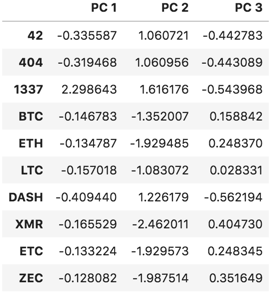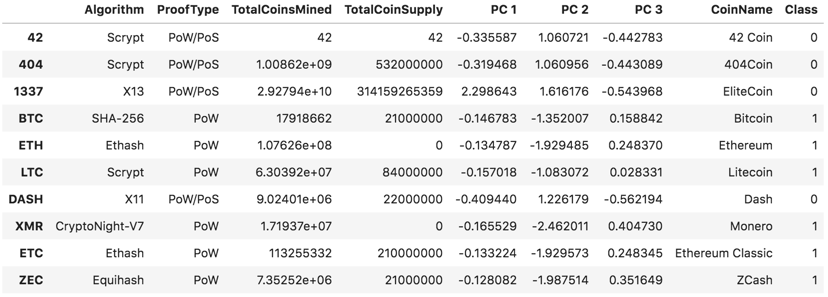 Cryptocurrencies coins by Worldspectrum | Free License
Cryptocurrencies coins by Worldspectrum | Free License
You are a Senior Manager at the Advisory Services team on a Big Four firm. One of your most important clients, a prominent investment bank, is interested in offering a new cryptocurrencies investment portfolio for its customers, however, they are lost in the immense universe of cryptocurrencies. They ask you to help them make sense of it all by generating a report of what cryptocurrencies are available on the trading market and how they can be grouped using classification.
In this homework assignment, you will put your new unsupervivsed learning and Amazon SageMaker skills into action by clustering cryptocurrencies and creating plots to present your results.
You are asked to accomplish the following main tasks:
-
Data Preprocessing: Prepare data for dimension reduction with PCA and clustering using K-Means.
-
Reducing Data Dimensions Using PCA: Reduce data dimension using the
PCAalgorithm fromsklearn. -
Clustering Cryptocurrencies Using K-Means: Predict clusters using the cryptocurrencies data using the
KMeansalgorithm fromsklearn. -
Visualizing Results: Create some plots and data tables to present your results.
-
Optional Challenge: Deploy your notebook to Amazon SageMaker.
In this section, you will load the information about cryptocurrencies and perform data preprocessing tasks. You can choose one of the following methods to load the data:
-
Using the provided
CSVfile, create aPathobject and read the file data directly into a DataFrame namedcrypto_dfusingpd.read_csv(). -
Using the following
requestslibrary, retreive the necessary data from the following API endpoint from CryptoCompare -https://min-api.cryptocompare.com/data/all/coinlist. HINT: You will need to use the 'Data' key from the json response, then transpose the DataFrame. Name your DataFramecrypto_df.
With the data loaded into a Pandas DataFrame, continue with the following data preprocessing tasks.
-
Keep only the necessary columns: 'CoinName','Algorithm','IsTrading','ProofType','TotalCoinsMined','TotalCoinSupply'
-
Keep only the cryptocurrencies that are trading.
-
Keep only the cryptocurrencies with a working algorithm.
-
Remove the
IsTradingcolumn. -
Remove all cryptocurrencies with at least one null value.
-
Remove all cryptocurrencies that have no coins mined.
-
Drop all rows where there are 'N/A' text values.
-
Store the names of all cryptocurrencies in a DataFrame named
coins_name, use thecrypto_df.indexas the index for this new DataFrame. -
Remove the
CoinNamecolumn. -
Create dummy variables for all the text features, and store the resulting data in a DataFrame named
X. -
Use the
StandardScalerfromsklearnto standardize all the data of theXDataFrame. Remember, this is important prior to using PCA and K-Means algorithms.
Use the PCA algorithm from sklearn to reduce the dimensions of the X DataFrame down to three principal components.
Once you have reduced the data dimensions, create a DataFrame named pcs_df using as columns names "PC 1", "PC 2" and "PC 3"; use the crypto_df.index as the index for this new DataFrame.
You should have a DataFrame like the following:
In this section, you will use the KMeans algorithm from sklearn to cluster the cryptocurrencies using the PCA data.
Perform the following tasks:
-
Create an Elbow Curve to find the best value for
kusing thepcs_dfDataFrame. -
Once you define the best value for
k, run theKmeansalgorithm to predict thekclusters for the cryptocurrencies data. Use thepcs_dfto run theKMeansalgorithm. -
Create a new DataFrame named
clustered_df, that includes the following columns"Algorithm", "ProofType", "TotalCoinsMined", "TotalCoinSupply", "PC 1", "PC 2", "PC 3", "CoinName", "Class". You should maintain the index of thecrypto_dfDataFrames as is shown bellow.
In this section, you will create some data visualization to present the final results. Perform the following tasks:
-
Create a 3D-Scatter using Plotly Express to plot the clusters using the
clustered_dfDataFrame. You should include the following parameters on the plot:hover_name="CoinName"andhover_data=["Algorithm"]to show this additional info on each data point. -
Use
hvplot.tableto create a data table with all the current tradable cryptocurrencies. The table should have the following columns:"CoinName", "Algorithm", "ProofType", "TotalCoinSupply", "TotalCoinsMined", "Class" -
Create a scatter plot using
hvplot.scatter, to present the clustered data about cryptocurrencies havingx="TotalCoinsMined"andy="TotalCoinSupply"to contrast the number of available coins versus the total number of mined coins. Use thehover_cols=["CoinName"]parameter to include the cryptocurrency name on each data point.
For the challenge section, you have to upload your Jupyter notebook to Amazon SageMaker and deploy it.
The hvplot and Plotly Express libraries are not included in the built-in anaconda environments, so for this challenge section, you should use the altair library instead.
Perform the following tasks:
-
Upload your Jupyter notebook and rename it as
crypto_clustering_sm.ipynb -
Select the
conda_python3environment. -
Install the
altairlibrary by running the following code before the initial imports.
!pip install -U altair-
Use the
altairscatter plot to create the Elbow Curve. -
Use the
altairscatter plot, instead of the 3D-Scatter from Plotly Express, to visualize the clusters. Since this is a 2D-Scatter, usex="PC 1"andy="PC 2"for the axes, and add the following columns as tool tips:"CoinName", "Algorithm", "TotalCoinsMined", "TotalCoinSupply". -
Use the
altairscatter plot to visualize the tradable cryptocurrencies usingx="TotalCoinsMined"andy="TotalCoinSupply"for the axes. -
Show the table of current tradable cryptocurrencies using the
display()command. -
Remove all
hvplotand Plotly Express references from your code.

